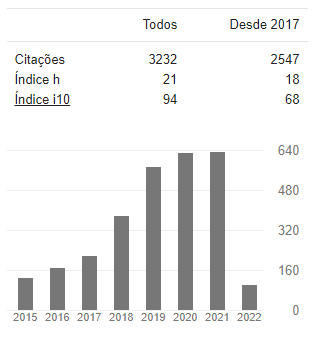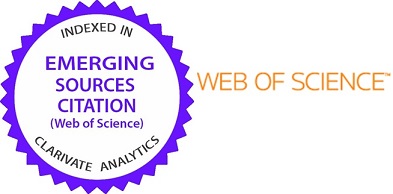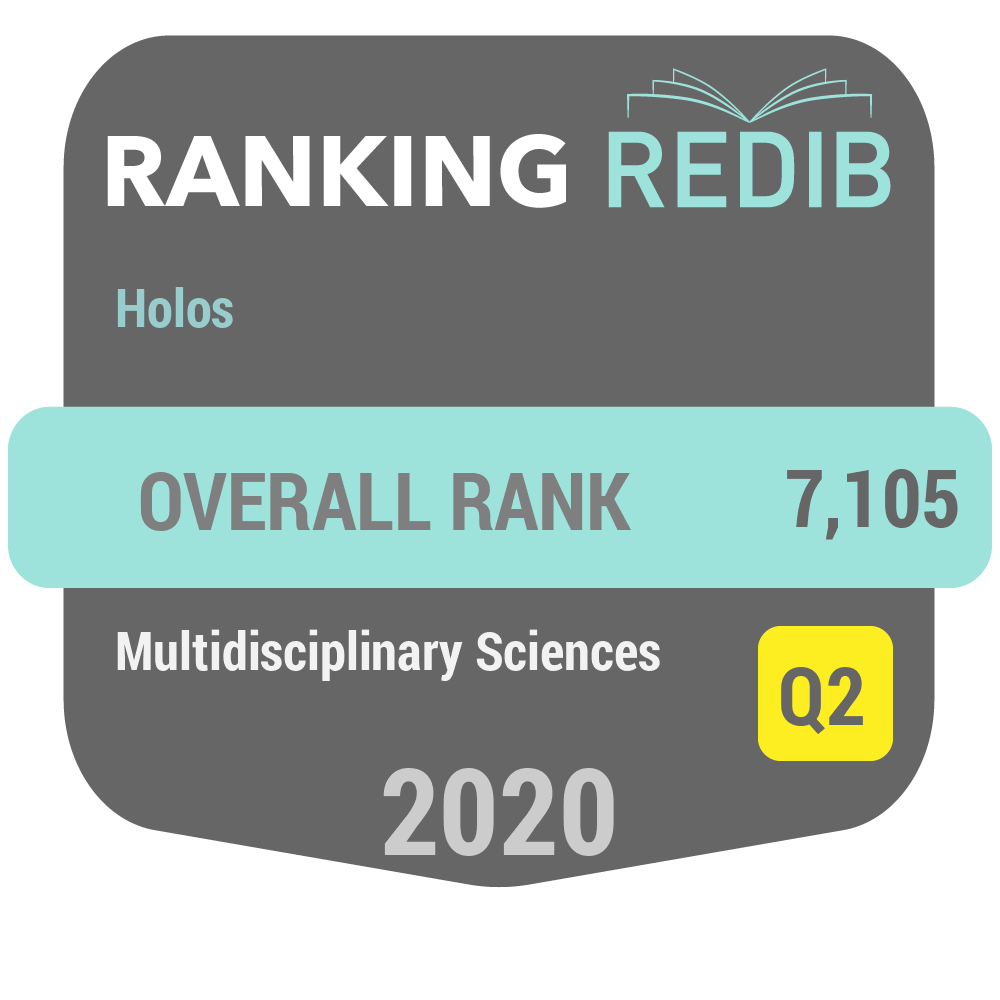USE OF LINEAR ALKYLBENZENE SULFONATE (LAS) AND POLYCARBOXYLATE-ETHER (PCE) AS REAGENTS IN IRON ORE FLOTATION
DOI:
https://doi.org/10.15628/holos.2017.6374Palavras-chave:
Flotation reagents, iron ore flotation, microflotation test, Yates algorithmResumo
Flotation is one of the separation techniques that has been used by the mineral industry and its importance has increased due to its better performance in the concentration of low grade ores. Specific chemical reagents are used in flotation in order to promote the hydrophobicity control of minerals dispersed in a pulp, among them, surfactants have been studied with good results. In this study, a substance based on Linear Alkylbenzene Solfonate (LAS), and a concrete admixture based on Policarboxilate-ether (PCE) were tested as reagents in iron ore flotation. The tests were performed in a friable hematite sample, using the microflotation technique. The Yates complete replicated factorial method for three variables and two levels was used in experimental planning. The variables evaluated was pH (9-11); LAS content (1000-5000 g/cm³); and PCE content (100-1000 g/cm³). The best result (84.1% floated) was obtained for combination pH=9, LAS content = 5000 g/cm³ and PCE content = 100 g/cm³
Downloads
Referências
ABNT. (2011). Aditivos químicos para concreto de cimento Portland - Especificações. NBR 11768. Rio de Janeiro: Associação Brasileira de Normas Técnicas - ABNT.
ABNT. (2011). Minérios de ferro - Procedimentos de amostragem e preparação de amostras. NBR ISO 3082. Rio de Janeiro: Associação Brasileira de Normas Técnicas - ABNT.
Araujo, A. C., Viana, P. M., & Peres, A. C. (2005). Reagents in iron ore flotation. Minerals Engineering, 18(2005), 219-224.
Box, G. P., Hunter, W. G., & Hunter, J. S. (1978). Statistics for experiments: an introduction for design, data analysis, and model building. John Wiley & Sons Inc.
Chemical book. (2016). Sodium dodecylbenzenesulphonate. Retrieved December 19, 2016, from http://www.chemicalbook.com/ChemicalProductProperty_EN_CB4852054.htm
Du, L., & Folliard, K. J. (2005). Mechanisms of air entrainment in concrete. Cement and Concrete Research, 35, 1463-1471.
Hartman, C., Jeknavorian, A., Silva, D., & Benini, H. (2011). Aditivos químicos para concretos e cimentos. In G. C. Isaia (Ed.), Concreto: ciência e tecnologia (pp. 347-380). São Paulo: Ibracon.
Houot, R. (1983). Beneficiation of iron ore by flotation - Review of industrial and potential applications. International Journal of Mineral Processing, 10(1983), 183-204.
Infomet. (2016). Minérios de ferro. Retrieved September 29, 2016, from Infomet: http://www.infomet.com.br/site/siderurgia-1a-minerios.php
Iwasaki, I. (1999). Iron Ore Flotation - Historical Perspective and Future Prospects. In SME, B. K. Parekh, & J. D. Miller (Eds.), Advances in Flotation Technology. Denver: Society for Mining, Metallurgy, and Exploration, Inc. - SME.
Lima, N. P., Pinto, T. S., Tavares, A. C., & Sweet, J. (2016). The entrainment effect on the performance of iron ore reversse flotation. Minerals Engineering, 96-97, 53-58.
Lima, N. P., Valadão, J. S., & Peres, A. C. (2013). Effect of particle size range on iron ore flotation. Revista Escola de Minas, 66(2), 251-256.
Liu, X., Wang, Z., Zhu, J., Zheng, Y., Cui, S., Lan, M., & Li, H. (2014). Synthesis, characterization and performance of a polycarboxylate superplasticizer with amide structure. Colloids and Surfaces A, 448, 119-129.
Luo, B., Zhu, Y., Sun, C., Li, Y., & Han, Y. (2015). Flotation and adsorption of a new collector alpha-Bromodecanoic acid on quartz surface. Minerals Engineering, 77, 86-92.
Luo, X., Wang, Y., Wen, S., Ma, M., Sun, C., Yin, W., & Ma, Y. (2016). Effect of carbonate minerals on quartz flotation behavior under conditions of reverse anionic flotation of iron ores. International Journal of Mineral Processing, 152, 1-6.
Ma, X., Marques, M., & Gontijo, C. (2011). Comparative studies of reverse cationic/anionic flotation of Vale iron ore. International Journal of Mineral Processing, 100, 179-183.
Marsh. D. (2015). Besting Bubbles. Concrete Products, 118, 66-68.
MC Bauchemie. (2015, November). MC-Powerflow4000 - Datasheet. Retrieved February 02, 2017, from MC-Bauchemie: http://www.mc-bauchemie.com.br/wp-content/uploads/2013/12/mc-powerflow-4000-11-2015.pdf
Mehta, P., & Monteiro, P. M. (2014). Concrete: microstructure, properties and materials (2nd. ed.). São Paulo: Ibracon.
Mendes, J. C. (2016). Technical feasibility of Linear Alkylbenzene Sodium Sulfonate use as air-entraining agent for cement-based materials. Master's thesis, Escola de Minas, Universidade Federal de Ouro Preto. Ouro Preto: UFOP.
Nascimento, D. R. (2010). Anionic flotation of iron ore. Master's thesis - Escola de Minas, Universidade Federal de Ouro Preto, 116. Ouro Preto: UFOP.
Ng, W. S., Sonsie, R., Forbes, E., & Franks, G. V. (2015). Floculation/flotation of hematite fines with anionic temperature-responsive polymer acting as selective flocculants and collector. Minerals Engineering, 77, 64-71.
Oliveira, J. F. (2007). Flotation. In M. T. CETEM, Brazil technological trends 2015: Geosciences and mineral technologies. Rio de Janeiro: CETEM/MCT.
Rabockai, T. (1979). Physical Chemistry of Surfaces. OEA.
Schackow, A., Effting, C., Folgueras, M. V., Guths, S., & Mendes, G. A. (2014). Mechanical and thermal properties of ligthweight concretes with vermiculite and EPS using air-entraining agents. Construction and Building Materials, 57, 190-197.
Sika. (2016). Superplasticizers. Retrieved December 19, 2016, from http://deu.sika.com/en/gypsum-mortar-redirect/sika-gypsum-mortars-solutions/gypsum-product-groups/superplasticizers.html
Turrer, H. D. (2007). Polymer depressants in iron ore flotation. Doctoral dissertation - Engenharia Metalúrgica e de Minas, Universidade Federal de Minas Gerais, 203. Belo Horizonte: UFMG.
Turrer, H. D., & Peres, A. E. (2010). Investigation on alternative depressants for iron ore flotation. Minerals Engineering, 23, 1066-1069.
Valle, T. A. (2012). Use of aerators in floatation: historical, concepts and emerging trends. Bachelor's thesis - Engenharia de Minas, Universidade Federal de Minas Gerais, 36. Belo Horizonte: UFMG.
Yang, Q., Zhu, P., Wu, X., & Huang, S. (2000). Properties of concrete with a new type of saponin air-entraining agent. Cement and Concrete Research, 30(8), 1313-1317.
Ypê. (2011, October 19). Impakto. Retrieved February 02, 2017, from https://www.impakto.com.br/sistema/produtoEspecificacao/110029.pdf
Ypê. (2014, April 3). Pratika. Retrieved February 2, 2017, from http://www.pratika.com.br/files/site/uploads/produtos/DETERGENTE_YPyU_500ml_-_QUIMICA_AMPARO.pdf









































